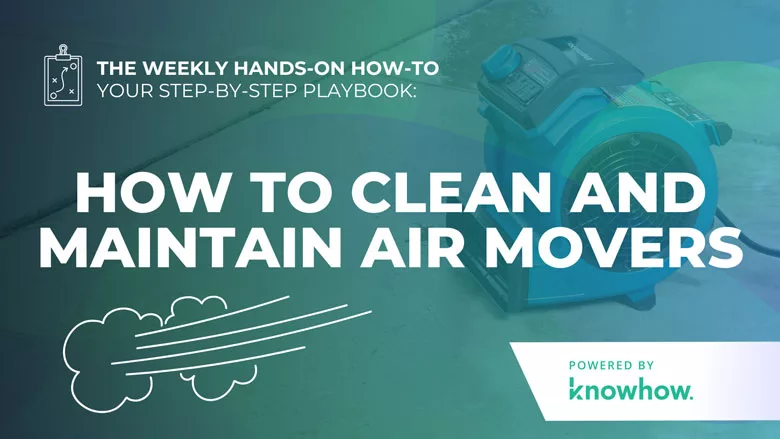Weekly Hands-on How-To powered by KnowHow
How to Clean and Maintain Air Movers
Keep your air movers running strong with this essential cleaning and troubleshooting guide

Image provided by KnowHow.
So you’ve kicked on the air mover… but it doesn’t have the same punch. The airflow feels weak, there’s a weird rattle, or maybe it’s just louder than it used to be. On a job site where every minute of drying matters, even small issues with your equipment can snowball into delays, callbacks, or worse—complete failure in the field.
That’s why basic airmover maintenance isn’t just a box to check. It’s how you keep your gear reliable, efficient, and job-ready. In this weekly How-To powered by KnowHow, we’ll walk through the essential steps for cleaning, troubleshooting, and maintaining your airmovers—so they keep doing their job, without slowing down yours.
1. Know Your Airmover
Air movers are foundational tools in water damage restoration. They accelerate evaporation, prevent secondary damage, and help meet drying goals fast. But like any piece of equipment, they rely on regular upkeep to perform reliably.
2. Troubleshoot Common Issues
Before you get hands-on with maintenance, it’s smart to know the most common problems that sideline airmovers in the field. Catching issues early can prevent bigger failures down the line:
- Not turning on: Double-check the power source, plug, switch, and cord.
- Weak airflow: Look for dust buildup or obstruction near the fan blades or vents.
- Excessive noise or vibration: Often caused by damaged or misaligned blades, or loose internal parts.
- Overheating: Could signal blocked airflow or overuse—give the unit breaks and make sure ventilation is clear.
3. Know the Basic Components
Understanding how an airmover is built helps you troubleshoot and maintain it. Most models include:
- Motor: Powers the airflow.
- Fan blades: Move air through the unit.
- Housing: The protective shell.
- Cord: Supplies power.
- Controls: Operate the speed and power.
- Feet/Base: Stabilize the unit on the ground.
Time to Dive Into Maintenance
Once you’ve diagnosed issues and understand how the unit is built, it’s time to roll up your sleeves. Regular maintenance not only keeps your airmover performing at its best—it also helps extend its service life and avoid expensive replacements. Here’s how to break it down, clean it out, and bring it back to full power:
4. Gather Your Supplies
Start by gathering everything you’ll need to get the job done efficiently:
- Vacuum cleaner
- Soft brush or cloth
- Mild detergent and water
- Screwdriver
5. Disconnect the Power
Safety first—always unplug the airmover before performing maintenance. If your unit uses a battery, remove it completely to prevent accidental activation.
6. Remove the Grill
Use a screwdriver to carefully remove the protective grill from the unit. This gives you access to the fan blades and internal components. Keep all screws in a safe place to avoid losing them during reassembly.
7. Clean the Equipment
Now that everything’s accessible, give the airmover a thorough clean:
- Exterior: Wipe down with a damp cloth.
- Fan blades: Brush off dust and debris, or use compressed air for tough spots.
- Motor vents: Use compressed air or a soft brush to clear away buildup.
- Power cord: Inspect for damage and clean it with a cloth—make sure it’s completely dry before use.
8. Reassemble the Airmover
Carefully reattach the grill and secure all screws or clips. Make sure the fan blades spin freely and nothing is misaligned before restoring power.
9. Perform Routine Maintenance
Keep your airmover running smoothly by building these practices into your routine:
- Motor checks: Watch for unusual sounds or overheating.
- Lubrication: Some models need periodic lubrication—check the manual.
- Fan blade alignment: Misaligned blades can reduce airflow and cause vibration.
- Vent inspection: Clear any debris blocking airflow through the intake or exhaust.
10. Store It the Right Way
When the job’s done, make sure your gear is ready for the next one:
- Dry storage: Keep it in a moisture-free location.
- Cord care: Loosely coil the cord to avoid damage—don’t wrap it too tightly around the unit.
Keep the Airflow Strong (and the Downtime Low)
Whether you're dealing with high humidity, a flooded basement, or a job that just won't dry fast enough, your airmovers are on the frontlines. But even the best equipment needs regular care to keep delivering peak performance.
With KnowHow, your team always knows how to break down, clean, and maintain key tools like airmovers without guesswork or phone calls. From step-by-step maintenance guides to on-the-job troubleshooting support, KnowHow makes it easy to build confidence and consistency into every restoration job.
Looking for an easy way to equip your crew with the know-how they need? Book a demo or download the airmover maintenance template today.
Looking for a reprint of this article?
From high-res PDFs to custom plaques, order your copy today!







